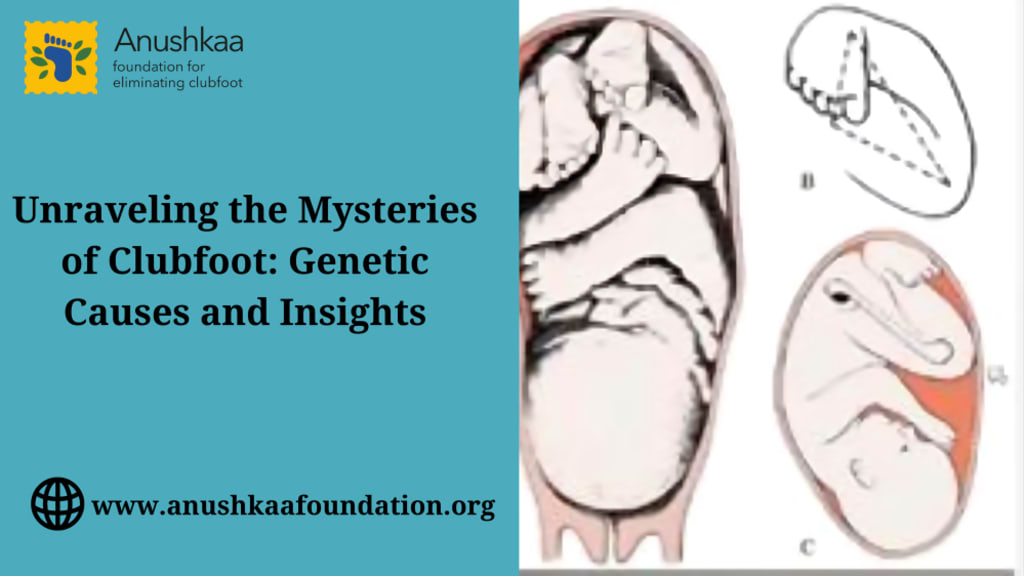Unraveling the Mysteries of Clubfoot: Genetic Causes and Insights
Congenital talipes equinovarus (CTEV), often known as clubfoot, is an orthopaedic disorder that affects newborns' feet. The term "clubfoot" refers to a condition where one or both feet are abnormally positioned and appear to be twisted inward and downward, mimicking the shape of a golf club.

Introduction
Clubfoot, a congenital orthopedic condition characterized by the inward and downward rotation of one or both feet, is a puzzling ailment that affects thousands of newborns worldwide. While the exact etiology of clubfoot remains elusive, scientific research has made substantial progress in understanding its genetic causes. In this article, we will delve into the intricate world of genetics to shed light on the factors contributing to clubfoot development and the implications for diagnosis, treatment, and prevention.
The Basics of Clubfoot
Congenital talipes equinovarus (CTEV), another name for clubfoot, is a condition in which the foot or feet are positioned abnormally at birth. The diseased foot may look twisted, with the sole bent inside and the heel pointed down. This condition might affect just one foot unilaterally or both feet bilaterally. Clubfoot frequently affects the muscles, tendons, and ligaments in the affected leg in addition to the bones, resulting in stiffness and decreased movement.
Even while clubfoot is not a life-threatening condition, untreated or poorly managed cases can lead to long-term problems, such as discomfort and trouble walking. To lessen the likelihood of adverse effects, early identification and action are essential.
Understanding the Genetic Component
Although the precise origin of clubfoot has remained a mystery for many years, mounting evidence points to the importance of genetics in the condition's emergence. Numerous research studies have been carried out to pinpoint the precise genes and genetic variants linked to clubfoot, illuminating the disorder's intricate genetic foundations.
Clubfoot's propensity to run in families is one of the earliest signs of a genetic link to the condition. A person's chance of getting clubfoot or passing it on to their children is higher if their family has a history of the ailment. This familial clustering strongly suggests that genetic factors play a role in the development of clubfoot.
Twin Studies: Twin studies have also provided compelling evidence for the hereditary nature of clubfoot. Identical twins, who share nearly identical genetic makeup, are more likely to both be affected by clubfoot compared to non-identical twins. These findings emphasize the genetic component's importance.
Candidate Genes: Over the past few decades, researchers have focused on identifying specific genes associated with clubfoot. Several candidate genes have emerged from these efforts, with one of the most prominent being PITX1. Mutations in the PITX1 gene have been linked to the development of clubfoot, particularly in isolated cases without a family history of the condition. Other candidate genes, such as TBX4 and TBX5, have also shown associations with clubfoot in some studies.
Polygenic Inheritance: It's important to note that clubfoot is not caused by a single gene but rather by a combination of genetic factors. Polygenic inheritance, where multiple genes contribute to the risk of developing clubfoot, appears to be the most likely scenario. This complexity makes it challenging to pinpoint the exact genetic culprits.
Environmental Influences: While genetics play a substantial role in clubfoot, environmental factors also contribute to its development. Factors like maternal smoking, maternal drug use during pregnancy, and certain prenatal conditions may increase the risk of clubfoot in genetically susceptible individuals.
Clinical Implications
Understanding the genetic causes of clubfoot has important clinical implications, particularly in the areas of diagnosis, treatment, and genetic counseling.
Early Diagnosis: Due to genetic research, diagnostic techniques that can locate certain genetic determinants linked to clubfoot have been developed. These examinations can be done throughout pregnancy, enabling early detection and intervention. Early diagnosis helps medical professionals design a customized treatment strategy and provide families with counseling regarding the hereditary basis of the problem.
Treatment Tailored to Genetic Profiles: Genetic information can guide orthopedic surgeons in tailoring treatment plans to individual patients. This personalized approach can improve the effectiveness of treatments like the Ponseti method, which involves gentle manipulation and casting of the affected foot, or surgical interventions when necessary.
Genetic Counseling: Families with a history of clubfoot or those who receive a genetic diagnosis for their child can benefit from genetic counseling. Genetic counselors can provide information about the likelihood of the condition recurring in future pregnancies, potential genetic testing options, and strategies for family planning.
Research and Development: A deeper understanding of the genetic causes of clubfoot can drive further research into targeted therapies and interventions. This research may ultimately lead to more effective treatments and, in some cases, the prevention of clubfoot in at-risk families.
Challenges in Clubfoot Genetics
While significant progress has been made in unraveling the genetic causes of clubfoot, several challenges remain.
Clubfoot is genetically heterogeneous, which means that a variety of genes and genetic variants may play a role in its development. This diversity underscores the necessity for extensive genetic investigations involving several groups and makes it challenging to pinpoint a single causal component.
Gene-Environment Interactions: It is difficult to predict how genetic and environmental factors will interact to cause clubfoot development. The difficult issue of identifying certain gene-environment interactions and their contributions to the illness calls for more research.
Ethics: The use of genetic data for early diagnosis and intervention raises concerns about privacy, informed permission, and the potential stigmatization of affected people or their families.
Conclusion
Congenital clubfoot has a complicated genetic foundation. Research has made tremendous progress in identifying potential genes and comprehending the hereditary basis of the disorder, even if the precise genetic reasons for clubfoot are still being clarified. Early detection, personalized treatment plans, and genetic counseling for affected families are now possible thanks to this understanding.
Improved treatments, preventative measures, and a clearer comprehension of the interaction between genes and the environment are all possible outcomes of ongoing research into the genetics of clubfoot. We are getting closer to our objective of ensuring that every child born with this illness has the finest treatment and opportunity for a happy life as we learn more about the genetic roots of clubfoot.
About the Creator
Enjoyed the story? Support the Creator.
Subscribe for free to receive all their stories in your feed. You could also pledge your support or give them a one-off tip, letting them know you appreciate their work.





Comments
There are no comments for this story
Be the first to respond and start the conversation.